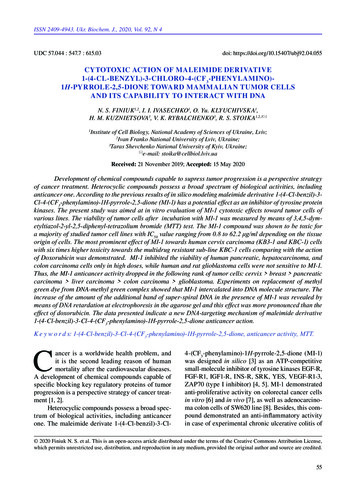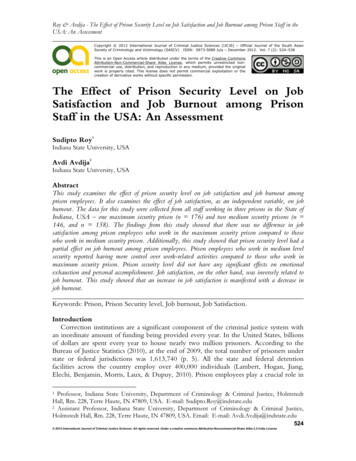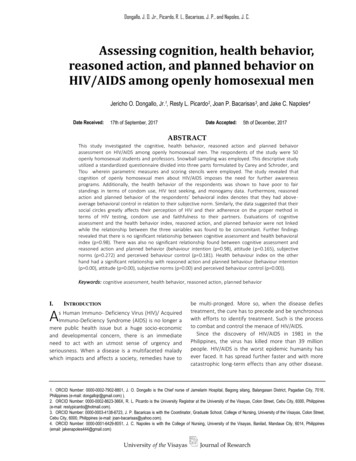
Transcription
ISSN 2409-4943. Ukr. Biochem. J., 2020, Vol. 92, N 4UDC 57.044 : 547.7 : 615.03doi: https://doi.org/10.15407/ubj92.04.055Cytotoxic action of maleimide ino)1H-pyrrole-2,5-dione toward mammalian tumor cellsand its capability to interact with DNAN. S. Finiuk1,2, I. I. Ivasechko1, O. Yu. Klyuchivska1,H. M. Kuznietsova3, V. K. Rybalchenko3, R. S. Stoika1,2,3 1Institute of Cell Biology, National Academy of Sciences of Ukraine, Lviv;2Ivan Franko National University of Lviv, Ukraine;3Taras Shevchenko National University of Kyiv, Ukraine; e-mail: stoika@cellbiol.lviv.uaReceived: 21 November 2019; Accepted: 15 May 2020Development of chemical compounds capable to supress tumor progression is a perspective strategyof cancer treatment. Heterocyclic compounds possess a broad spectrum of biological activities, includinganticancer one. According to the previous results of in silico modeling maleimide derivative e-2,5-dione (MI-1) has a potential effect as an inhibitor of tyrosine proteinkinases. The present study was aimed at in vitro evaluation of MI-1 cytotoxic effects toward tumor cells ofvarious lines. The viability of tumor cells after incubation with MI-1 was measured by means of 3,4,5-dymetyltiazol-2-yl-2,5-diphenyl-tetrazolium bromide (MTT) test. The MI-1 compound was shown to be toxic fora majority of studied tumor cell lines with IC50 value ranging from 0.8 to 62.2 μg/ml depending on the tissueorigin of cells. The most prominent effect of MI-1 towards human cervix carcinoma (KB3-1 and KBC-1) cellswith six times higher toxicity towards the multidrug resistant sub-line KBC-1 cells comparing with the actionof Doxorubicin was demonstrated. MI-1 inhibited the viability of human pancreatic, hepatocarcinoma, andcolon carcinoma cells only in high doses, while human and rat glioblastoma cells were not sensitive to MI-1.Thus, the MI-1 anticancer activity dropped in the following rank of tumor cells: cervix breast pancreaticcarcinoma liver carcinoma colon carcinoma glioblastoma. Experiments on replacement of methylgreen dye from DNA-methyl green complex showed that MI-1 intercalated into DNA molecule structure. Theincrease of the amount of the additional band of super-spiral DNA in the presence of MI-1 was revealed bymeans of DNA retardation at electrophoresis in the agarose gel and this effect was more pronounced than theeffect of doxorubicin. The data presented indicate a new DNA-targeting mechanism of maleimide -1Н-pyrrole-2,5-dione anticancer action.K e y w o r d s: le-2,5-dione, anticancer activity, МТТ.Cancer is a worldwide health problem, andit is the second leading reason of humanmortality after the cardiovascular diseases.A development of chemical compounds capable ofspecific blocking key regulatory proteins of tumorprogression is a perspective strategy of cancer treatment [1, 2].Heterocyclic compounds possess a broad spectrum of biological activities, including anticancerone. The maleimide derivate le-2,5-dione (MI-1)was designed in silico [3] as an ATP-competitivesmall-molecule inhibitor of tyrosine kinases EGF-R,FGF-R1, IGF1-R, INS-R, SRK, YES, VEGF-R1-3,ZAP70 (type I inhibitor) [4, 5]. MI-1 demonstratedanti-proliferative activity on colorectal cancer cellsin vitro [6] and in vivo [7], as well as adenocarcinoma colon cells of SW620 line [8]. Besides, this compound demonstrated an anti-inflammatory activityin case of experimental chronic ulcerative colitis of 2020 Finiuk N. S. et al. This is an open-access article distributed under the terms of the Creative Commons Attribution License,which permits unrestricted use, distribution, and reproduction in any medium, provided the original author and source are credited.55
ISSN 2409-4943. Ukr. Biochem. J., 2020, Vol. 92, N 4rats [9] and possessed low general toxicity in laboratory animals [7, 10, 11].Protein kinases are enzymes that regulate different cellular processes including cell proliferation,differentiation and migration, cell cycle regulation,and metabolism [2, 12]. A deregulation of these processes via mutations or over-expression of kinasesleads to various diseases [13, 14]. Kinases play animportant role in the carcinogenesis and metastases of different types of cancer [2, 15]. Thus, a development of protein kinases inhibitors is of greatinterest for the cancer treatment. A number of protein kinases inhibitors, such as imatinib [16], benzotriazines, quinazolines, pyrazolopyrimidines,imidazo[1,5-a]pyrazines, pyridopyrimidinones andother heterocycles, ATP-phospho-peptide conjugateshave been developed and investigated for the treatment of cancer [12, 17-19].It is obvious that the multifunctional anticancer agents affecting different bio-molecules and biological processes could be more efficient treatmentremedies comparing to such agents with only onebio-target in the tumor cells. The aim of our studywas to carry out a search for novel biological targetsat the cytotoxic action of maleimide derivative MI-1,namely evaluating a possibility that DNA moleculecould also be such target. Besides, we addressed apotential toxic effect of MI-1 towards mammaliantumor cell lines, specifically the drug-resistant tumor cells not studied earlier.Materials and methodsCompounds under study. The synthesis ofmaleimide derivate e-2,5-dione (MI-1, Fig. 1)was carried out by successive chemical transformations, as described previously [6, 11]. The stock solution of MI (10 mg/ml) was prepared in the DimethylSulfoxide (DMSO, Sigma-Aldrich, St. Louis, MO,USA), and before adding to the cultured cells, further solutions were prepared using culture medium.Doxorubicin (Actavis S.R.L., Bucharest, Romania)was used as a positive control anticancer drug.Cell culture and anti-proliferative MTT assay.Human pancreatic ductal adenocarcinoma Capan-1cells, human epidermoid cervix carcinoma KB3-1cells and its colchicine-resistant sub-line KBC-1,that is characterized by over-expression of plasmamembrane P-glycoprotein, were donated by a Collection of the Institute for Cancer Research at Vienna Medical University (Vienna, Austria). Human breast56Fig. 1. Schematic structure of the 3phenylamino)-1Н-pyrrole-2,5-dione)adenocarcinoma MCF-7 and MDA231, human coloncarcinoma HCT116 cells, human hepatocarcinomaHepG2 cells were obtained from the Collection atthe Institute of Experimental Pathology, Oncologyand Radiobiology (Kyiv, Ukraine). Human glioblastoma cells of U251, U373 and T98G lines, rat gliomaC6 cells were obtained from a Collection at the Institute of Molecular Biology and Genetics, NationalAcademy of Sciences of Ukraine (Kyiv, Ukraine).Cells were grown in RPMI-1640 (Biowest, Nuaille,France) or Dulbecco’s-modified Eagle’s medium(DMEM, Biowest, Nuaille, France) culture mediumsupplemented with 10% fetal bovine serum (Biowest, Nuaille, France) at the standard conditions(37 C in an atmosphere of 5% CO2).The MI-1 cytotoxicity towards tumor cellsin vitro was measured using colorimetric MTT(3-(4,5-dimethyl thiazol-2-yl)-2,5-diphenyl tetrazolium bromide, Sigma-Aldrich, USA) assay for estimating functional activity of the treated cells. Cellswere plated at 5,000 cells/well (substrate-dependentcells) or 15,000 cells/well (suspension cells) in 100 µlof 96-well plates and allowed to grow overnight. TheMI-1 or Doxorubicin at 1, 10, and 100 µg/ml wasadded in 100 µl of cultural medium, and cells wereincubated for the next 72 h. After that, the MTT assay was performed according to the manufacturer’srecommendations (Sigma-Aldrich, St. Louis, MO,USA). The absorbance of formazan was measuredby an Absorbance Reader BioTek ELx800 (BioTekInstruments, Inc., Winooski, VT, USA). The IC50level of MI-1 was calculated as the drug concentration that reduced cell viability by 50% [20].Electrophoretic gel retardation assay of plasmid DNA. Plasmid DNA (1 μg) pEGFPc-1 (Clontech, Mountain View, California, USA) was mixedwith 2 μl of MI-1 (1; 10; 100 μg/ml), and Dox (1 and
N. S. Finiuk, I. I. Ivasechko, O. Yu. Klyuchivska et al.Results and DiscussionCytotoxicity study. In this study, human tumorcells of different tissue origin, namely leukemia, cervix, breast, glioblastoma, and pancreas, were subjected to the action of the MI-1 compound applied inthree doses - 1, 10, and 100 μg/ml. The MTT assaywas used for evaluation of the antineoplastic activity of the MI-1. It was found that the MI-1 inhibitedgrowth of human breast adenocarcinoma MCF-7cells with the IC50 of 9.7 μg/ml (Fig. 2, Table), whilethe Doxorubicin demonstrated higher cytotoxi city towards these tumor cells (IC50 1.9 μg/ml).However , human breast adenocarcinoma cells of theMDA231 line were relatively resistant to the actionof MI-1 in dose up to 50 μg/ml (Fig. 2, Table).Rapid development of the multidrug resistan ce is one of the main problems in cancer treatment.Among the main mechanisms of such resistanceare the over-expression of the ABC transporters onplasma membrane, mutations in the BRCA gene,DYNLL1 gene and other mechanisms that promotedrug inactivation and/or degradation [23, 24]. In thisstudy, we compared the anti-neoplastic activity ofthe MI-1 towards human epidermoid cervix carcinoma cells of KB3-1 line and its colchicine-resistantKBC-1 sub-line that is characterized by P-glycoprotein over-expression. The MI-1 proved to be sixtimes more effective in growth inhibition of KBC-1cells (IC50 0.8 μg/ml), comparing to Doxorubicin(IC50 4.8 μg/ml), while at targeting wild type KB31 line, the picture was opposite and these cells weremore sensitive to the Doxorubicin (IC50 0.3 μg/ml)than to the MI-1 (IC50 7.5 μg/ml) (Fig. 2, Table).Thus, the MI-1 was shown to be capable of circumventing drug resistance mechanism dependent on Pglycoprotein over-expression.The MI-1 also inhibited growth of humanpancreatic ductal adenocarcinoma Capan-1 cells(IC50 18.0 μg/ml), human hepatocarcinoma HepG2cells (IC50 33.5 μg/ml), and human colon cancerHCT116 cells (IC50 62.2 μg/ml) (Fig. 3, Table).These concentrations are much higher than thoseMDA231MCF7KBC-1KB3-1100Cell viability, % of control10 μg/ml) in 18 µl of 0.9% sodium chloride (Arterium, Lviv, Ukraine) at room temperature for 1 h.Prepared mixture was analyzed by electrophoresisin 1% agarose gel (Lachema, Brno, Czech Republic)with 1 Tris acetate (TAE) buffer containing 1 μg/ml of Ethydium bromide (Sigma-Aldrich, St. Louis,Missouri, USA) for approximately 1 h at a constantvoltage of 70 V. The trans-illuminator (MacroVueUV-20, Hoeffer, Troy, Michigan, USA) was used forvisualization of plasmid DNA [21].DNA intercalation assay using methyl greenreplacement. Methyl green binds to DNA with anabsorption maximum at 642 nm. Free methyl greendoes not show absorption at this wavelength, whilethe compounds that bind/intercalate with DNA replaced methyl green from the complex of methylgreen–DNA and decreased the optical density at642 nm wave length. 485 µl of salmon sperm DNA(50 μg/ml, Sigma-Aldrich, St. Louis, Missouri,USA) were incubated for 1 h at 37 C with 15 µl ofmethyl green (Sigma-Aldrich, St. Louis, Missouri,USA) solution (1 mg/ml in water). 500 µl of MI-1 (1and 10 μg/ml), or Dox (10 μM) were added to methyl green-DNA complex and incubated for 2 h at37 C in the dark. The Ethydium bromide (EtBr, 1and 10 μg/ml) was used as a positive control. Absorption of methyl green was measured at 630 nm[22] using a fluorescence plate reader (AbsorbanceReader BioTek ELx800, BioTek Instruments, Inc.,Winooski, Vermont, USA).Data analysis. The results were analyzed andillustrated using Origin software (version 7). Alldata are presented as the mean (M) standard deviation (SD) of three independent replications. A t testwas used for statistical analysis. Statistical significance was identified at P 0.05.806040200020406080100MI-1, µg/mlFig. 2. The anti-proliferative activity of e-2,5dion (MI-1) towards human breast adenocarcinoma(MCF-7 and MDA 231) cells, human epidermoidcervix carcinoma cells of KB3-1 line and its colchicine-resistant KBC-1 sub-line. Cell viability was examined using the MTT assay after 72 h cell exposureto the MI-1 compound57
ISSN 2409-4943. Ukr. Biochem. J., 2020, Vol. 92, N 4KB3-1KBC-1Capan-1Hep G2HCT 116 wtMCF-7MDA231U251U373T98GC6IC50, µg/mlMI-17.50.818.033.562.29.7 50 50 50 50 50Dox0.34.80.20.60.81.91.60.40.70.41.3mentioned above for inhibition of human epidermoid cervix carcinoma cells of KB3-1 line and itscolchicine-resistant KBC-1 sub-line. These doses ofthe MI-1 compound are also much higher than thecytotoxic doses of the Doxorubicin (Table).Human glioblastoma cells of U251, U373, andT98G and rat glioma C6 lines were relatively nonsensitive to the MI-1 action, and the IC50 level wasabove 50 μg/ml, while IC50 for Doxorubicin indicated high cytotoxic effect of the last chemotherapeuticdrug (Fig. 4, Table).Study of interaction of the MI-1 with DNA.The e-2,5-dion (MI-1) was designed in silico as aninhibitor of tyrosine kinases [3] that are importanttargets in the action of many anticancer drugs [4, 5].However, other biological targets of the MI-1’s effectcannot be excluded. In order to address such possibility, we have suggested that the DNA moleculecould be another target that is used at the cytotoxicaction of the MI-1 compound. It is known that seve ral FDA approved anticancer therapeutics, such asdoxorubicin, cisplatin, bleomycin, chlorambucil,etoposide, mephalan can bind the DNA and in sucha way affect its structure and functions [22, 25, 26].Besides, the Reactive Oxygen Species (ROS) induced in treated cells by the above noted anticancerdrugs can cause the oxidative damage of DNA m
maleimide derivate 1-(4-Cl-benzil)-3-Cl-4-(CF 3-phenylamino)-1Н-pyrrole-2,5-dione (MI-1, Fig. 1) was carried out by successive chemical transforma-tions, as described previously [6, 11]. The stock solu-tion of MI (10 mg/ml) was prepared in the Dimethyl Sulfoxide (DMSO, Sigma-Aldrich, St. Louis, MO, USA), and before adding to the cultured cells .











